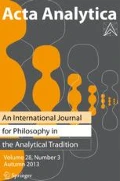Two arguments Paul Snowdon has brought against the causal theory of perception are examined. One involves the claim that, based on the phenomenology of perceptual situations, it cannot be the case that perception is an essentially causal concept. The other is a reductio, according to which causal theorists’ arguments imply that a proposition Snowdon takes to be obviously non-causal (A is married to B) can be analyzed into some sort of indefinite ‘spousal connection’ plus a causal ingredient. I conclude that neither argument is sound. The reason that Snowdon’s critiques fail is that, since causal theories need not be about ‘effect ends’ that are internally manifest to perceivers, no such ostensibly separable, non-causal property as it being to S as if he were perceiving O need be an essential element in a causal theory of perception.
Similar content being viewed by others
Notes
Numerous other versions of this definition may be found in Vision 1997. It is noteworthy that Snowdon himself has fluctuated a bit on precisely how to put this definition. In Snowdon 1981:175-176 the “causal thesis” is any claim to the effect that it is necessarily true that if any S sees any public object O, then O causally affects S. But Snowdon takes the whole causal theory to be comprised not only of that thesis, but also to assert (i) that the sort of effect of this causal process is reportable in a “looks-statement;” and (ii) that the other two theses are “conceptual truths.” In Snowdon 1990: 123, these three theses are put into a single proposition, thus arguably defining CTP more restrictively than I have. The definition in that work is, roughly, It is a conceptual requirement that, necessarily, if S perceives O then O is causally responsible for an experience undergone by S. This could be held to be stronger than my definition, which entails only two of the three Snowdon theses, since it makes no explicit reference to any final or culminating experience of S of a kind that S may consciously access and name. I do not wish to deny, however, that perceivings, veridical or not, are experiences (conscious or unconscious) undergone by perceivers, although it is not clear to me that they must always be reportable in the manner Snowdon at one time required. I have no qualms, that is, about the use of ‘perceives’ in my definition being taken to entail that, for any S, if S perceives O, S has an experience. I hope it will become clear as we proceed to what extent, if any, the terminological differences between our renderings of CTP matter.
After all, an object’s “getting drier” isn’t itself actually separable in any obvious way from its proximate predecessors.
As can be seen, the addition of the phenomenological provision in CTP* allows the promise of sufficient, as well as necessary, conditions for perception. But no causal story is here being required for this “as if” state of affairs itself.
In addition, it seems likely that formulation of the precise causal conditions that are alone sufficient to produce perception of O is tantamount to solving the ‘hard problem’ of consciousness.
Although I cannot make the case here, it is my view that the main defect in disjunctivism is not the claim that there may be no common epistemic factor between a merely ostensible and an apparently identical veridical perceptual experience; it is insisting that there can never be any such common factor.
References
Byrne and Logue (eds.). (2009). Disjunctivism: Contemporary readings. Cambridge, Mass.: MIT Press.
Grice, H. P. (1961). The causal theory of perception. Proceedings of the Aristotelian Society, 35, 121–152.
Hallett, H. F. (1949). On a reputed equivoque´ in the philosophy of Spinoza. The Review of Metaphysics, 3, 189–212.
Horn, W. (2010). Reid and Hall on Perceptual Relativity and Error. Journal of Scottish Philosophy, 8(2), 115–145.
Hinton, J. M. (1967). Visual experiences. Mind, 76, 217–227.
Hinton, J. M. (1973). Experiences: An iInquiry into some ambiguities. Oxford: Oxford University Press.
McDowell, J. (1982). Criteria, Defeasibility and Knowledge. Proceedings of the British Academy, 68, 455–479.
McDowell, J. (2002). Knowledge and the Internal Revisited. Philosophy and Phenomenological Research, 64, 97–105.
Putnam, H. (1999). The threefold cord. New York: Columbia University Press.
Snowdon, P. (1980-1981). Perception, vision, and causation. Proceedings of the Aristotelian Society, 81, 175–192.
Snowdon, P. (1990). The Objects of Perceptual Experience. Proceedings of the Aristotelian Society, 64, 121–166.
Tye, M. (2007). Intentionalism and the Argument from no Common Content. Philosophical Perspectives, 21, 589–613.
Vision, G. (1997). Problems of Vision. Oxford: Oxford University Press.
Author information
Authors and Affiliations
Corresponding author
Rights and permissions
About this article
Cite this article
Horn, W. Note on Two Snowdon Criticisms of the Causal Theory of Perception. Acta Anal 27, 441–447 (2012). https://doi.org/10.1007/s12136-011-0143-z
Received:
Accepted:
Published:
Issue Date:
DOI: https://doi.org/10.1007/s12136-011-0143-z




